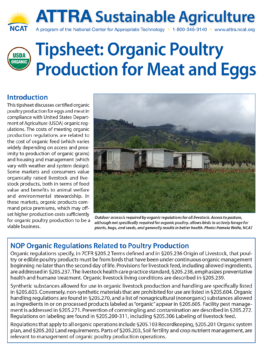Tipsheet: Organic Poultry Production for Meat and Eggs
By Ann Baier, NCAT Agriculture Specialist
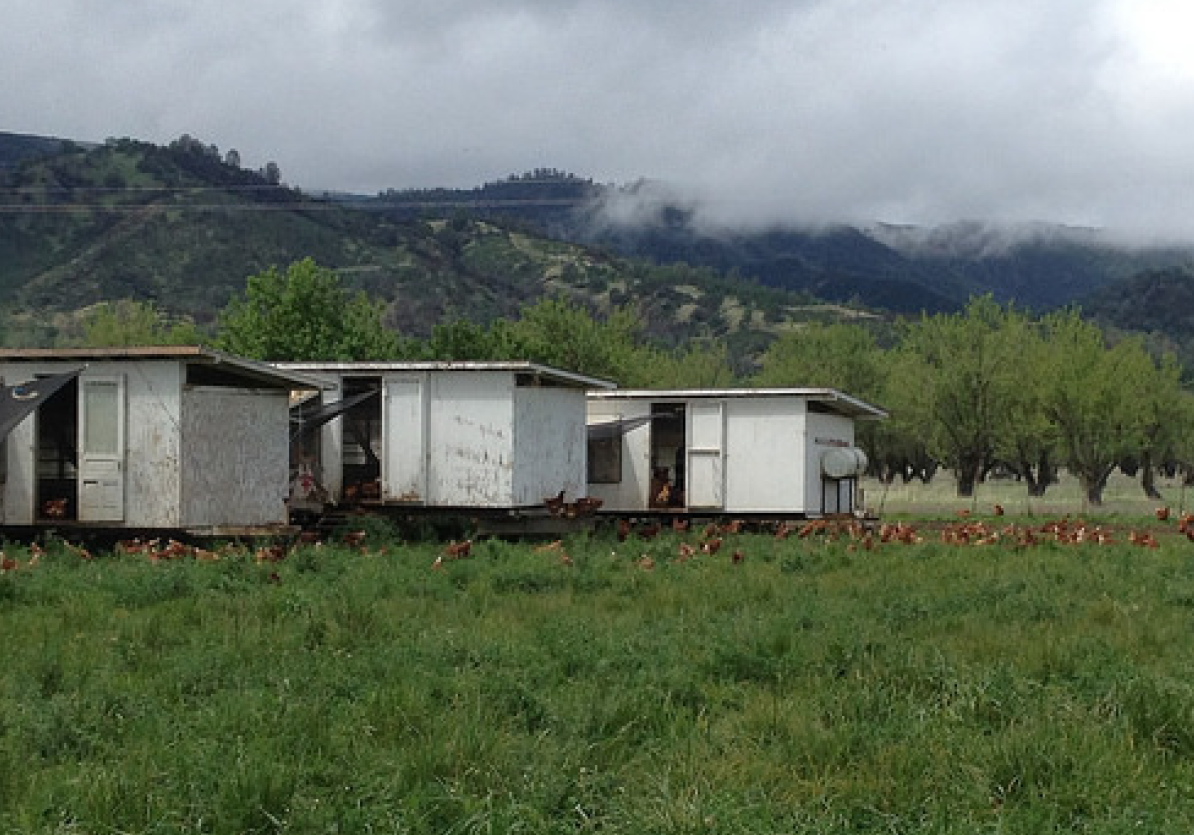
Outdoor access is required by organic regulations for all livestock. Access to pasture, although not specifically required for organic poultry, allows birds to actively forage for plants, bugs, and seeds, and generally results in better health. Photo: Pamela Wolfe, NCAT
Introduction
This tipsheet discusses certified organic poultry production for eggs and meat in compliance with United States Department of Agriculture (USDA) organic regulations. The costs of meeting organic production regulations are related to the cost of organic feed (which varies widely depending on access and proximity to production of organic grains) and housing and management (which vary with weather and system design). Some markets and consumers value organically raised livestock and livestock products, both in terms of food value and benefits to animal welfare and environmental stewardship. In these markets, organic products command price premiums, which may offset higher production costs sufficiently for organic poultry production to be a viable business.
NOP Organic Regulations Related to Poultry Production
Organic regulations specify, in 7CFR §205.2 Terms defined and in §205.236 Origin of Livestock, that poultry or edible poultry products must be from birds that have been under continuous organic management beginning no later than the second day of life. Provisions for livestock feed, including allowed ingredients, are addressed in §205.237. The livestock health care practice standard, §205.238, emphasizes preventative health and humane treatment. Organic livestock living conditions are described in §205.239.
Synthetic substances allowed for use in organic livestock production and handling are specifically listed in §205.603. Conversely, non-synthetic materials that are prohibited for use are listed in §205.604. Organic handling regulations are found in §205.270, and a list of nonagricultural (nonorganic) substances allowed as ingredients in or on processed products labeled as “organic” appear in §205.605. Facility pest management is addressed in §205.271. Prevention of commingling and contamination are described in §205.272. Regulations on labeling are found in §205.200-311, including §205.306 Labeling of livestock feed.
Regulations that apply to all organic operations include §205.103 Recordkeeping, §205.201 Organic system plan, and §205.202 Land requirements. Parts of §205.203, Soil fertility and crop nutrient management, are relevant to management of organic poultry production operations.
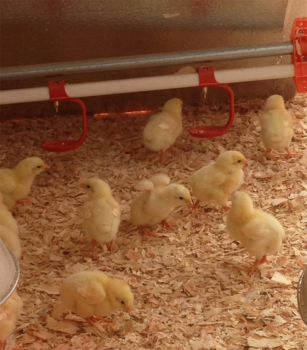
A clean environment for young birds, along with selection of well-adapted poultry breeds, are foundations of preventative health care for organic poultry. Photo: Ann Baier, NCAT
Selection of Animal Type and Breeds; Source of Livestock
According to USDA organic regulations, an organic livestock producer must select species and types of livestock that are suitable to the site, well-adapted to the climate, and resistant to diseases and parasites that are common in the area. Poultry breeds vary with respect to the range of temperature in which they thrive and maintain good productivity. Some do better in colder climates; others tolerate heat better. Some are better foragers; others grow faster. Producers should seek a balance of desirable characteristics. Hatchery breed descriptions and producer experience can guide breed selection. For organic production, one-day old chicks and poults may be purchased from any hatchery. (Poultry farm advisors recommend purchasing only from breeding flocks approved by the USDA National Poultry Improvement Program, which certifies flocks to be free of certain diseases.) Organic management must begin no later than the second day of life.
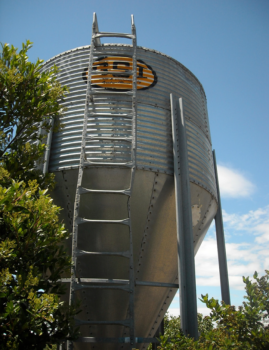
Organic poultry must be provided with rations that are 100% organic and allowed ingredients for good nutrition and productivity. A grain silo is one way to protect feed from the elements and pests. Photo: Ann Baier, NCAT
Nutrition: Feed, Supplements, and Additives
Organic poultry must be fed rations sufficient to meet nutritional requirements, including vitamins, minerals, protein and/or amino acids, fatty acids, energy sources, and fiber. Agricultural ingredients must be certified organic. Oyster shell may be used as a calcium supplement to strengthen eggshells. All feed rations, additives, and supplements must be listed with complete brand name, formulation, and manufacturer in the producer’s Organic System Plan (OSP).
Synthetic methionine is an amino acid that may be used in certified organic feed rations in limited quantities that are specified by the regulations (two pounds per ton of chickenfeed; three pounds per ton of turkey or other poultry feed). This level of use will be allowed until the sunset date on this regulation. (Please check with your certifier and the National Organic Program website to verify this date.)
Organic poultry producers must not use animal drugs, including hormones, to promote growth. (The U.S. Food and Drug Administration prohibits hormone use in all poultry production, whether organic or non-organic.) Additionally, organic producers must avoid products such as non-organic “medicated” chick starter, which includes antibiotics. Arsenic is included in some non-organic broiler feed as a feed stimulant and for protozoan parasite control. Arsenic should not be included in organic rations; its use is prohibited for organic crop production, so it must not be “applied” to organic land through poultry manure. Organic producers must not use feed supplements or additives in amounts above what is needed for adequate nutrition and health maintenance. Organic regulations specify that it is prohibited to feed mammalian or poultry slaughter by-products to mammals or poultry, or to use any feed, feed additives, and feed supplements in violation of the Federal Food, Drug, and Cosmetic Act.
Although pasture is not required for organic poultry, outdoor access is required. Production systems that allow poultry to forage fulfill the requirement for outdoor access and can provide for healthy living conditions. Pasture-based systems can be certified organic when they use organic feed, preventative health care, and avoid prohibited materials. House-based systems are also permitted for organic production, provided they allow for access to the outdoors and direct sunlight, and otherwise fulfill all other regulatory requirements described below in Living Conditions.

Laying hens on pasture with clean water, Solseeker Farm at Hain Ranch Organics. Photo: Ann Baier, NCAT
Preventative Health Care
Organic regulations require preventative health care, beginning with appropriate selection of species and breeds, an overall healthy environment with good sanitation and biosecurity measures to prevent the spread of diseases, and measures to minimize stress. Vaccination against prevalent diseases of poultry is allowed in organic poultry production, as long as the vaccines are not genetically modified. Vaccines commonly used in the United States include those for Marek’s disease, Newcastle disease, and infectious bronchitis. Preventative practices and healthy living conditions, such as maintaining clean feeding and watering systems, are critical to reducing diseases such as Coccidiosis, which is caused by a protozoan parasite. Probiotics, or beneficial microbes, may be fed or added to drinking water to establish beneficial microflora. These work in the poultry’s gut, through competitive exclusion, to reduce pathogenic organisms such as Salmonella and E. coli.
Use of parasiticides is prohibited in organic slaughter stock of any kind, including poultry. Parasiticides are limited to uses specified in the Livestock healthcare practice standards, the National List, and only by written order of a licensed veterinarian if required. Organic regulations §205.238(b) specify the conditions under which parasiticides may be used. §205.238(c)(6) also states “The producer of an organic livestock operation must not: Administer animal drugs in violation of the Federal Food, Drug, and Cosmetic Act”. The producer must, therefore, be aware of, and avoid recommendations for off-label use of any drug.
Physical alterations of organic livestock are allowed only when necessary to promote the animals’ welfare, and when they are performed in a matter that minimizes pain and stress. Most organic producers find alterations such as beak trimming to be unnecessary when they have designed their systems and management practices to provide adequate space, include roosters for natural social order, and use other strategies to reduce stress among birds.
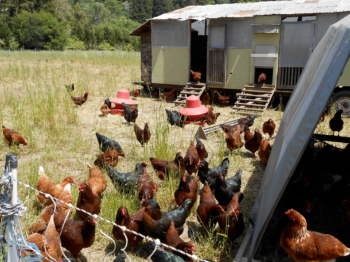
Living conditions required by organic regulations include access to the outdoors, shade, shelter, exercise areas, fresh air, clean water for drinking, and direct sunlight, as shown at Everett Family Farm. Photo: Ann Baier, NCAT
Living Conditions
A healthy environment that minimizes stress is foundational to production of healthy birds. Organic poultry, like all organic livestock, must have access to the outdoors, shelter, exercise areas, fresh air, clean drinking water, shade, and direct sunlight–suitable for the animal’s stage of life, climate, and environment. Animals need to express their natural behaviors to maintain good health. For poultry, this includes exercise, roosting, scratching, and dustbathing, which, among other benefits, helps control ectoparasites.
Chicks, poults, and other young birds are typically confined during brooding to keep them warm and safe from predators. Outdoor access is required for all poultry once they have adequate feathering. Confinement of poultry after this stage of development—about four weeks for chickens—must be documented and justified according to the reasons for temporary confinement allowed in §205.239: inclement weather; stage of life; health, safety, or well-being; risk to soil or water quality; healthcare—illness or injury; sorting, shipping or sale; breeding; and youth projects.
Housing must be designed to protect birds from the elements, with reasonable temperatures for health and stress reduction. Although organic programs in other countries, and animal welfare programs in the United States, specify minimum per-bird requirements for roost space, housing area, and outdoor access, as well as limits on the size and density of flocks, NOP organic regulations do not quantify how much living or roosting space is adequate. Instead, they focus on qualitative descriptions of living conditions and the purpose of the requirements: that livestock producers create living conditions that minimize stress. Any production practice that restricts space or outdoor access, or otherwise compromises healthy living conditions, will not comply with organic regulations.
In organic production, use of lumber treated with prohibited materials is not allowed where it will contact soil, crops, or livestock.
Supplemental lighting, commonly used in layer operations to diminish seasonal dips in rate of lay during winter months, is not specifically addressed in the organic regulations. Describe your proposed practices with respect to lighting in your Organic System Plan (OSP), to be reviewed and approved by your certifier.
Good air quality is extremely important to birds’ health because dust and high levels of ammonia in the air can cause respiratory problems. Adequate ventilation, appropriate bedding (high-carbon material to absorb the nitrogen in the manure), and regular cleaning of poultry housing are all important.
Feed-storage facilities, feeder design, and maintenance procedures must keep poultry feed clean. Practical considerations (some of which are common sense and not covered explicitly in organic regulations) are listed below:
- Provide balanced rations and adequate feed to birds. Layers are often fed free choice, such that they may eat their fill. However, fast-growing meat birds, such as Cornish cross, are prone to heart attacks and leg problems when they overeat; their daily feed quantity needs to be limited to reasonable rations for the breed.
- Protect feed from factors that diminish its nutritional quality and health, such as moisture (which may allow growth of undesirable microorganisms) and excess heat (which degrades vitamins).
- Manage rodents to prevent both feed loss through consumption and introduction of pathogens through rodent droppings.
- To prevent disease and parasite reinfection, position feeders to prevent birds from standing, scratching, or defecating in the feed.
Watering equipment needs to provide a reliable supply of clean, cool water. Birds drink twice as much, by weight, as they eat. Because they eat in proportion to their drinking, poultry health, growth, and productivity depend on a reliable supply of good water. Poultry prefer cool water over warm water. Check and maintain watering systems regularly to ensure reliable function and prevent leaks that waste water and create fly habitat.
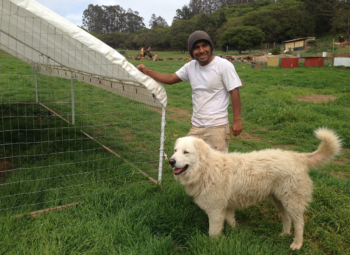
Pastured poultry farmer Aurelio Lopez of Fiesta Farm with guard dog. Photo: Ann Baier, NCAT
Predator management, while not directly addressed by organic regulations, is necessary for the safety and well-being of both poultry and predators. Keeping predators at bay is critical to the survival, health, and stress reduction of poultry. In addition, the manner in which predator management is accomplished must maintain or improve the natural resources of the operation, including soil and water, wetlands, woodlands, and wildlife. Predator management practices must be designed and carried out in ways that prevent wildlife contact with livestock. Producers must “train” each type of potential predator not to perceive their livestock as prey. Protecting livestock against predators must be done with conscientious planning in order to protect the lives of both potential predator and potential prey to promote ecological balance, as is required by the definition of “organic production” in §205.2 of the organic regulations.
Predator management strategies should consider some combination of the following: physical barriers such as housing and fencing; deterrents such as “predator eyes” lights, motion sensor lights or sprinklers; management barriers such as placement of housing to make livestock less accessible to ground and air predators; and regular presence of humans and well-trained guard animals. Certain breeds of dogs have especially good instincts and can respond well to training for this occupation.
Regulations §205.239(a)(3) require producers to establish conditions for livestock health including appropriate, clean, dry bedding. Roughages used as bedding must be certified organic. “Bedding” is interpreted to include materials used to line nest boxes to protect and keep eggs clean. Any agricultural products used for that purpose, such as straw or rice hulls, must be certified organic. Organic certification is generally not applicable to forest products, such that wood shavings need not be organic, but must consist only of plant material that is not treated with any prohibited substances.
Manure management is a critically important part of an organic livestock operation. Per §205.239(e), “The producer of an organic livestock operation must manage manure in a manner that does not contribute to contamination of crops, soil, or water by plant nutrients, heavy metals, or pathogenic organisms and optimizes recycling of nutrients and must manage pastures and other outdoor access areas in a manner that does not put soil or water quality at risk.” Although hydrated lime is allowed per §205.603 as an external pest control, its use is not permitted to cauterize physical alterations or to deodorize animal wastes.
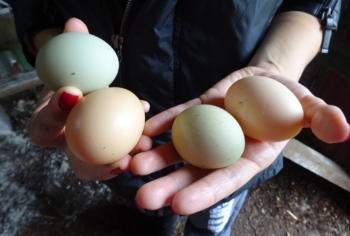
Freshly gathered eggs. Eggshell colors are characteristic of different breeds of laying hens. Photo: Ann Baier, NCAT
Handling (Processing)
Handling facilities for processing meat or eggs may be on- or off-farm. Regardless of their location, organic operations must comply with all applicable federal, state and local laws, such as those related to meat inspection and marketing, egg handling and egg handler registration, sanitation, water use, and waste management.
In order to sell eggs as organic, they must be handled in certified organic handling facilities and using allowed materials. Materials commonly used in egg handling include cleaners, sanitizers, and egg-coating materials. These are listed in §205.605(a) and (b) with any restrictions on their use as sanitizers (e.g. chlorine materials, hydrogen peroxide, peracetic or peroxyacetic acid); defoaming agents (ingredients must be organic or on the National List, e.g., silicon dioxide, organic vegetable oil), and egg coatings (organic oils). As noted above, any material planned for use must be listed in your OSP and approved by your certifier for its intended use. In addition to being allowed under NOP organic regulations, egg handling methods and materials must meet federal regulations: USDA Grading Standards (Agricultural Marketing Service or AMS); Egg Products Inspection Act or EPIA, Egg Safety Rule, and Food Code (Food and Drug Administration); the National Poultry Improvement Act (Animal and Plant Health Inspection Service or APHIS); Flock Health & Production, Research, Statistical Information (from the Food Safety and Inspection Service or FSIS, Agricultural Research Service or ARS, and National Agricultural Statistics Service or NASS). They must also meet state and local requirements as applicable, such as regulations of State Departments of Agriculture, Departments of Health Services, Industry Marketing Boards, and Farmers Market Boards, as well as Retail Food Codes.
Similarly, in order for a producer to sell poultry meat as organic, it must be handled (processed) in a certified organic facility, using allowed practices and substances. Any materials used on equipment, food-contact surfaces, and organic products themselves must be: a) on the National List as allowed; b) listed in your OSP; and c) approved by your certifier for their intended use. Materials commonly used for poultry meat production include soaps/cleaners and sanitizers used in scalders and on evisceration tables, scales, or any other food-contact surfaces that organic products touch.
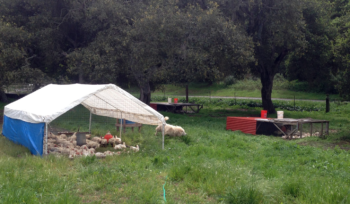
Turkeys on pasture. Photo: Ann Baier, NCAT
Recordkeeping
Documentation needed to show implementation of the producer’s Organic System Plan and compliance with the National Organic Program organic regulations includes the following:
- Source of birds (purchase receipts or brooding/hatching records)
- Feed sources (receipts and labels for purchased rations and feed supplements, production or purchase of organic forage or other agricultural feedstuffs)
- Preventative health care practices
- Production, handling, and sales records (meat-bird slaughter, packaging and sales; or egg collection, washing, candling, grading, and sales)
- Labels must be part of the producer’s OSP, approved by the certifier, and compliant with government regulations for labeling of meat (e.g. inspection or exemption, and safe food handling instructions) and eggs (“Sell by…[30 days from pack date]”, Julian date, keep refrigerated, etc.). See the ATTRA publication entitled Small-Scale Egg Handling for further details.
Resources
National Organic Program Resources
USDA Organic Regulations 7 CFR 205
USDA National List of Allowed and Prohibited Substances
USDA National Organic Program Handbook
- PM 11-12 Confinement of Poultry Flocks Due to Avian Influenza, or Other Infectious Diseases
- NOP 5029 The Use of Kelp in Organic Livestock Feed
Market News and Transportation Data: Organic Poultry and Eggs
NCAT/ATTRA Resources
Publications
- Documentation Forms for Organic Crop and Livestock Producers
- Pastured Poultry Nutrition and Forages
- Small-Scale Egg Handling
- Small-Scale Poultry Processing
Videos
Organic Poultry Production for Meat and Eggs
By Ann Baier, NCAT Agriculture Specialist
© 2015 National Center for Appropriate Technology—NCAT
IP405
This publication is produced by the National Center for Appropriate Technology through the ATTRA Sustainable Agriculture program, under a cooperative agreement with USDA Rural Development. This publication was also made possible in part by funding from the U.S. Department of Agriculture’s Agricultural Marketing Service, National Organic Program. ATTRA.NCAT.ORG.

